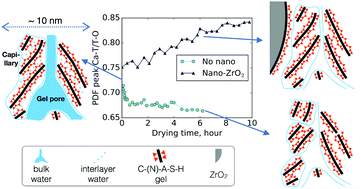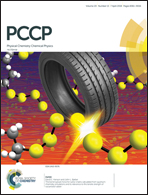Drying-induced atomic structural rearrangements in sodium-based calcium-alumino-silicate-hydrate gel and the mitigating effects of ZrO2 nanoparticles†
Abstract
Conventional drying of colloidal materials and gels (including cement) can lead to detrimental effects due to the buildup of internal stresses as water evaporates from the nano/microscopic pores. However, for these gel materials the underlying nanoscopic alterations that are, in part, responsible for macroscopically-measured strain values (especially at low relative humidity) remain a topic of open debate in the literature. In this study, sodium-based calcium-alumino-silicate-hydrate (C-(N)-A-S-H) gel, the major binding phase of silicate-activated blast furnace slag (one type of low-CO2 cement), is investigated from a drying perspective, since it is known to suffer extensively from drying-induced microcracking. By employing in situ synchrotron X-ray total scattering measurements and pair distribution function (PDF) analysis we show that the significant contributing factor to the strain development in this material at extremely low relative humidity (0%) is the local atomic structural rearrangement of the C-(N)-A-S-H gel, including collapse of interlayer spacing and slight disintegration of the gel. Moreover, analysis of the medium range (1.0–2.2 nm) ordering in the PDF data reveals that the PDF-derived strain values are in much closer agreement (same order of magnitude) with the macroscopically measured strain data, compared to previous results based on reciprocal space X-ray diffraction data. From a mitigation standpoint, we show that small amounts of ZrO2 nanoparticles are able to actively reinforce the structure of silicate-activated slag during drying, preventing atomic level strains from developing. Mechanistically, these nanoparticles induce growth of a silica-rich gel during drying, which, via density functional theory calculations, we show is attributed to the high surface reactivity of tetragonal ZrO2.

- This article is part of the themed collection: 2018 PCCP HOT Articles


 Please wait while we load your content...
Please wait while we load your content...